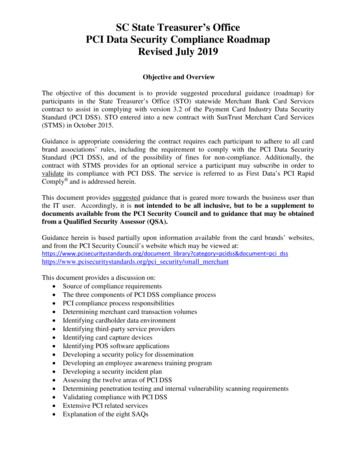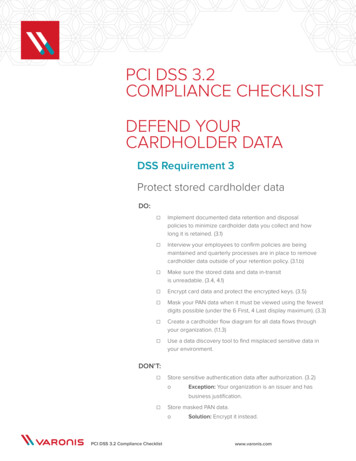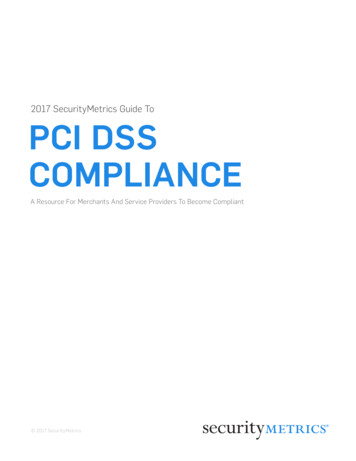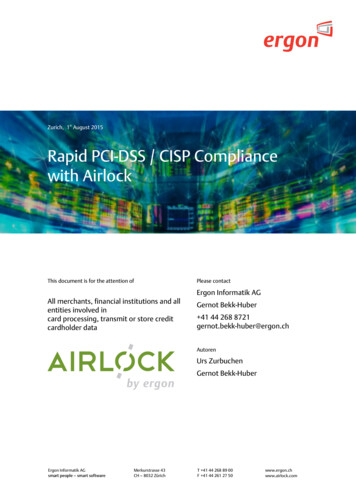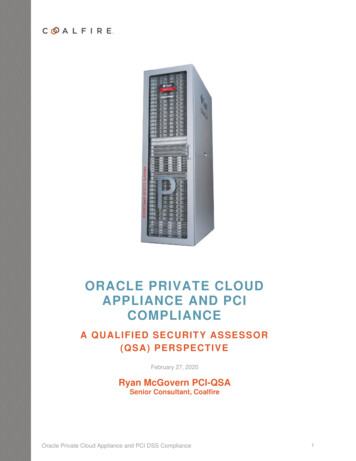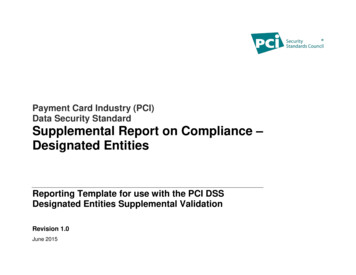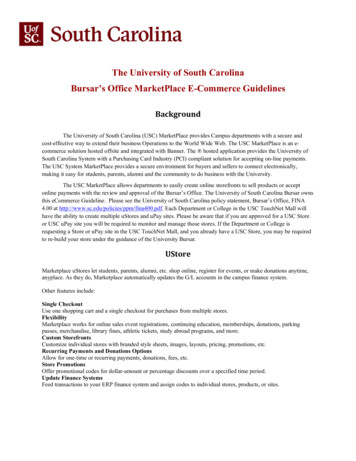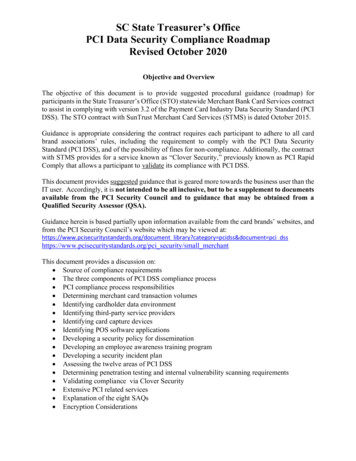
Transcription
SC State Treasurer’s OfficePCI Data Security Compliance RoadmapRevised October 2020Objective and OverviewThe objective of this document is to provide suggested procedural guidance (roadmap) forparticipants in the State Treasurer’s Office (STO) statewide Merchant Bank Card Services contractto assist in complying with version 3.2 of the Payment Card Industry Data Security Standard (PCIDSS). The STO contract with SunTrust Merchant Card Services (STMS) is dated October 2015.Guidance is appropriate considering the contract requires each participant to adhere to all cardbrand associations’ rules, including the requirement to comply with the PCI Data SecurityStandard (PCI DSS), and of the possibility of fines for non-compliance. Additionally, the contractwith STMS provides for a service known as “Clover Security,” previously known as PCI RapidComply that allows a participant to validate its compliance with PCI DSS.This document provides suggested guidance that is geared more towards the business user than theIT user. Accordingly, it is not intended to be all inclusive, but to be a supplement to documentsavailable from the PCI Security Council and to guidance that may be obtained from aQualified Security Assessor (QSA).Guidance herein is based partially upon information available from the card brands’ websites, andfrom the PCI Security Council’s website which may be viewed at:https://www.pcisecuritystandards.org/document library?category pcidss&document pci dsshttps://www.pcisecuritystandards.org/pci security/small merchantThis document provides a discussion on: Source of compliance requirements The three components of PCI DSS compliance process PCI compliance process responsibilities Determining merchant card transaction volumes Identifying cardholder data environment Identifying third-party service providers Identifying card capture devices Identifying POS software applications Developing a security policy for dissemination Developing an employee awareness training program Developing a security incident plan Assessing the twelve areas of PCI DSS Determining penetration testing and internal vulnerability scanning requirements Validating compliance via Clover Security Extensive PCI related services Explanation of the eight SAQs Encryption Considerations
PCI Compliance RoadmapCompletion of many of the tasks listed above may be necessary in order to successfully answerthe Self-Assessment Questionnaire (SAQ) that the participant is required to prepare, either throughClover Security or otherwise.1. Source of Compliance RequirementsCompliance with the PCI DSS is a contractual requirement of the merchant card servicesprovider (SunTrust Merchant Services, LLC) and the acquirer bank (SunTrust Bank, N.A.),which jointly utilizes Fiserv as the processor. The standard, which is subject to revisions, ispromulgated by the PCI Data Security Council.2. The Three Components of PCI DSS Compliance ProcessThe PCI compliance process involves three components: Compliance – Performing required tasks and maintaining systems appropriately,which must be done throughout the year (not just an annual event). Validation – Preparing an annual Self-Assessment Questionnaire (SAQ) andperforming any required external vulnerability scanning on a quarterly basis, ifapplicable. Attestation – Certifying compliance with the standard. Attestation can be through anonline reporting tool or by completing and submitting an “Attestation of Compliance”(AOC).3. PCI Compliance Process ResponsibilitiesSince merchant cards processing is associated with IT systems, financial systems, andbusiness users, it is imperative that there be a coordination of all parties and activities involvedin the validation process. PCI DSS compliance is a result of management’s decision to acceptmerchant cards, and as such, this decision may require extensive support from IT. Thus, PCIDSS compliance is primarily deemed to be a business problem with an IT solution.One of the best practices for ensuring a coordination of the interests and responsibilities ofboth sectors is to establish a PCI Oversight Committee. The creation of a committee charteris recommended. A sample charter is available from STO.The other two components of the process (validation and attestation) are normally theresponsibility of someone in the business sector. It is the business sector that is responsiblefor adhering to accounting, administrative, and procurement policies. Additionally, it issomeone in the business sector that is involved in the execution of the contractual arrangementwith the merchant card provider and will be addressing any issues that may result from noncompliance or breaches (e.g., inquiries from the card brands or law enforcement agencies).STO PCI Data Security Compliance Roadmap (Revised October 2020)Page 2
PCI Compliance Roadmap4.Determining Merchant Card Transaction VolumesThe card brands, not the PCI Security Council, determine what merchants must do in order tovalidate their PCI compliance. The determination is based upon annual transaction volumes.There are four established levels under which a merchant will fall: 1, 2, 3, or 4. All participantsin the State’s contract are currently either a Level 3 or 4 merchant.A) Level 1 and 2 merchantsLevel 1 merchants are required to have an annual onsite security audit performed by aqualified security assessor (QSA). Level 2 merchants are required to have either an annualonsite security audit performed by a qualified security assessor (QSA) or a passing SelfAssessment Questionnaire (SAQ) along with a corresponding Attestation of Compliance(AOC). If a PCI Approved Qualified Security Assessor (QSA) is engaged to assist with thepreparation of the merchant’s SAQ, the QSA must come on-site.As an alternative, Level 2 merchants may choose to complete a Self-AssessmentQuestionnaire using an internal security auditor (ISA). In order to use an internal auditor, themerchant must ensure that the primary internal auditor staff person engaged in validating PCIDSS compliance attends PCI SSC ISA training and passes the associated accreditationprogram annually.In addition, level 1 and 2 merchants must undergo external vulnerability scanning, ifapplicable (utilize capture systems involving external/public facing IP addresses).B) Level 3 and 4 merchantsLevel 3 and 4 merchants must complete an annual self-assessment questionnaire (SAQ) andundergo external vulnerability scanning, if applicable. On-site security audits are notnecessarily required of level 3 and 4 merchants.C) Transaction volumesThe transaction volume used in determining the appropriate merchant level is that of the“doing business as” (DBA) entity, which in most cases is associated with the participant’sprimary merchant ID (MID) level, not individual outlet MID levels, departments, or paymentchannels. Under the State’s master contract, STMS/Fiserv monitors each participant’stransaction total volume and e-commerce volume and makes the official determination of theparticipant’s PCI level.A participant can ascertain its annual transaction volume, for each card brand, through allpayment channels, to determine its assigned merchant level. Each brand specifies calculatingits own card transaction volume only to determine the assigned level. However, the brandwith the lower volume defers to the brand with the higher volume as the level that is to beassigned. For example, most participants will have more Visa transactions than MasterCardSTO PCI Data Security Compliance Roadmap (Revised October 2020)Page 3
PCI Compliance Roadmaptransactions. Those participants will therefore use the Visa transaction volume to determineits assigned level. Total transaction volumes across all brands are not to be considered.The following exercise will assist in determining which level you are likely considered.Transaction volumes can be determined through the merchant card processor’s onlinereporting tool (e.g., ClientLine) and from reports provided by any gateway services utilized.E-commerceAnnual Merchant Card Transactions VolumeVisa TransactionsMasterCard TransactionsNon eTotalENon eTotalcommercecommercecommerceThe first transaction volume to consider is the e-commerce volume for the higher brand. Ifthe e-commerce transaction volume is between 20,000 and 1 million (regardless of the numberof total transactions), the participant is considered a level 3 merchant.The second transaction volume to consider is the total number of transactions for the higherbrand. If the participant is not considered a level 3 merchant by virtue of having at least 20,000e-commerce transactions, and the total number of transactions is less than 1 milliontransactions, the participant is considered a level 4 merchant.The threshold for moving from merchant level 3 to merchant level 2 is one million totaltransactions of the higher card brand (e.g., Visa). From the perspective of validationrequirements (i.e., annual SAQ and quarterly external vulnerability scanning), there is nodifference between being a level 3 and level 4 merchant.5.Identifying the Cardholder Data EnvironmentThe steps to follow to validate PCI compliance, and the complexity of complying, will dependupon the cardholder data environment (CDE). The scope of PCI pertains to any system thateither, “processes,” “transmits,” or “stores” cardholder data. This could be in-house systemsor systems outsourced to a service provider. Therefore, it is necessary to perform a completeinventory of where and how merchant cards are accepted for payment.The State’s merchant card provider (STMS) has assigned each participant (considered a legalentity) a “primary” merchant ID (MID), sometimes referred to as a “head chain MID” or a“chain-chain number.” Under the primary MID, there is at least one “outlet MID.” There couldbe multiple outlet MIDs, one assigned to each business unit, location, or payment channel. Theparticipant’s primary MID and associated outlet MIDs can be viewed through STMS’sreporting tool (ClientLine). A participant’s PCI compliance attestation is done at the primaryMID level.In the case of an outsourced arrangement with a service provider, the provider is consideredpart of the CDE. The owner of the primary MID and associated outlet MIDs is considered themerchant of record (MOR), which in most cases is the participant.However, even if the service provider is the MOR, the entity making the sale or providing theservice is consider the “merchant” under the PCI-DSS and is responsible for complying withSTO PCI Data Security Compliance Roadmap (Revised October 2020)Page 4
PCI Compliance Roadmapcertain elements of the standard. The PCI Security Council’s definition of a merchant is: “Forthe purposes of the PCI DSS, a merchant is defined as any entity that accepts payment cardsbearing the logos of any of the five members of PCI SSC (American Express, Discover, JCB,MasterCard or Visa) as payment for goods and/or services.”If the service provider is considered the MOR, the merchant being provided the service (sellerof product or service) is considered a “sub-merchant.” Both entities are responsible for beingPCI DSS compliant.A) E-commerce Versus Non e-commerceAt the highest level, the two main categories of cardholder data environment (CDE) are: ecommerce and non-e-commerce.Cardholder Data Environment (CDE) for the Participant’s ChainNon e-commerce Outlet MIDsE-commerce Outlet MIDs(Face-to-face and MOTO capture)(Website O Mail Order Telephone Order)The appropriate Self-Assessment Questionnaire (SAQ) selected will be based upon the CDEand capture methods. (See Section 16 below.)B) External Facing IP AddressesOutlet MIDs that are associated with external (public) facing IP addresses must be identified,as the IP addresses are subject to undergoing external vulnerability scanning performedquarterly by an approved scanning vendor (ASV). See Section 14 below for ASV options.Firewall and network segmentation configurations must be taken into consideration whendetermining which IP addresses are in scope.Servers for capture solutions connected via the internet, including VOIP and PCs being usedas a virtual terminal, should be included. Capture of a cardholder data in the case of a virtualterminal application can be either keyed via the PC’s keyboard or via a magstripe deviceconnected to the PC. In most cases, web solutions that involve an “URL redirect” are notsubject to external vulnerability scanning. However, connected web servers facilitatingredirects are in PCI scope for other PCI requirements (e.g., anti-virus updates, etc.). POSterminals connected via an analog telephone line are not subject to scanning.Outlet MIDs Associated with External-Facing IP AddressesIn-House HostedWebVirtual Terminal(Key or swiped)POS TerminalConnected to IPSTO PCI Data Security Compliance Roadmap (Revised October 2020)POS SoftwareConnected to IPPage 5
PCI Compliance Roadmap6. Identifying Third-Party Service ProvidersOutsourcing merchant card processing to third-party service providers can limit the scope ofPCI compliance, but not eliminate it. The PCI Security Council defines a service provider asany “business entity that is not a payment brand, directly involved in the processing, storage,or transmission of cardholder data. This also includes companies that provide services thatcontrol or could impact the security of cardholder data.” A service provider would thereforeinclude any company providing a gateway service, a data storage service, or a web hostingservice. The merchant’s responsibilities pertaining to service providers are identified byRequirements 12.8 and 12.9 of the PCI DSS.The merchant’s responsibilities regarding a service provider are to: 1) maintain a list of serviceproviders; 2) ensure that the provider is compliant by performing a due diligence evaluationprior to engagement; 3) ensure the provider’s continued status of compliance by havingestablished an ongoing monitoring process; and 4) have in place a written agreement thatidentifies the provider’s responsibilities regarding compliance roles.Requirement 12.9 of the standard requires the service provider to acknowledge in writing itsresponsibility for PCI compliance. A “matrix of responsibilities” document is required, toidentify (clarify) the responsibilities of each the participant and the service provider(Requirement 12.8.5).South Carolina Interactive, LLC (SCI), now branded as NIC-South Carolina , the State’s webportal provider (SC.Gov), is considered a service provider. Touchnet used by universities is anexample of a service provider. As a provider of various payment gateways (PayPoint, Payeezy,CardConnect), STMS is considered a service provider.A) Levels of Service ProvidersThe card brands classify service providers according to two levels, just as merchants areclassified into four levels. While both levels are required to complete a SAQ and to undergoexternal vulnerability scanning, only level 1 service providers are required to undergo an onsitesecurity assessment by a qualified security assessor (QSA). The participant should identifywhich level each of its service providers is classified.Participant’s Third Party Service ProvidersLevel 1Level 2Processes more than 300,000 transactionsannuallyProcesses less than 300,000 transactionsannuallyService provider is required to undergo an Service provider is not required to undergoonsite security assessment by a QSAan onsite security assessment by a QSAThe participant should determine who within the organization has the responsibility ofperforming the due diligence and monitoring process, and the frequency. To assist merchantsSTO PCI Data Security Compliance Roadmap (Revised October 2020)Page 6
PCI Compliance Roadmapin their due diligence process of determining and monitoring PCI compliance of a serviceprovider, Visa and MasterCard both maintain a global registry of services providers that haveregistered with them. The registries can be viewed at: http://www.visa.com/splisting/ to-know.html.A level 2 service provider may not necessarily be registered with Visa, in which case themerchant should secure evidence of compliance directly from the provider. If the serviceprovider is a Level 1 service provider, the provider should be able to furnish evidence of its“Report on Compliance” (ROC).B) Written Agreement with Service ProvidersThe participant should inspect its engagement contract with each service provider to ensure itcontains the appropriate language to comply with Requirements 12.8 and 12.9 of the standard.If the contract does not (e.g., for older contracts), it is recommended that an addendum beprepared and executed to incorporate the new requirement, including a “matrix ofresponsibilities.”Although the standard does not require the written agreement to specify the liability of theservice provider in the event of a security breach, it is best practice to address the issue. Thelack of specificity of liability in the case of a security breach could leave the participant at riskregarding the potential paying of fines assessed by the card brands.C) Participant Functioning as a Service ProviderThere may be cases where the participant may possibly be deemed to be functioning as aservice provider. This could be the case where a third-party vendor utilizes the participant’snetwork to process merchant card transactions. Examples of such entities could include anoutsourced food service vendor (e.g., Aramark), occasional entertainers (e.g., HarlemGlobetrotters), or a legally separate entity but considered a component of the participant (e.g.,certain bookstore arrangements). It is possible for such arrangements to be structured such thatthe participant is only contractually agreeing to provide the entity “web access only service,”thereby limiting the participant’s PCI-DSS exposure.D) Internal Service ProvidersConsultation with the State’s Division of Technology Office (DTO) may be necessary if DTOhosts servers utilized by the participant. DTO could be considered an internal service provider.In some cases, another governmental entity could be an internal service provider. Whomanages the servers determines who is responsible for having the servers undergo externalvulnerability scanning on behalf of the merchant.7. Identifying Card Capture DevicesCard data capture devices are of various types, including point of sale (POS) terminals witheither swipe devices or keypads. All terminals and devices must be PCI compliant.STO PCI Data Security Compliance Roadmap (Revised October 2020)Page 7
PCI Compliance RoadmapRequirement 9.9 of the standard addresses the physical protection of devices that capturepayment card data. The purpose is to protect both tampering and substitution of the devices.While the requirement is mandatory for swipe devices, it is recommended for key devices,such as computer keyboards and POS keypads.The requirement specifically requires the merchant to: 1) maintain an updated list of devices;2) periodically inspect device surfaces to detect tampering or substitution; and 3) providetraining to employees to be aware of attempted tampering or substitution.The participant should institute procedures to periodically physically inspect for fraudulentskimmers that may be attached to devices, and to check for fraudulent substitution by checkingthe serial numbers of the devices. Training of employees should include the requirements to:1) verify the identity of any third-party persons claiming to be repair or maintenance personnel;and 2) be aware of suspicious behavior around devices (for example, attempts by unknownpersons to unplug or open devices).The first step in complying with Requirement 9.9 is for the participant to prepare an inventoryof all devices, including those in both production and storage.Card Capture DevicesLo
Compliance with the PCI DSS is a contractual requirement of the merchant card services provider (SunTrust Merchant Services, LLC) and the acquirer bank (SunTrust Bank, N.A.), which jointly utilizes Fiserv as the processor. The standard, which is subject to revis
